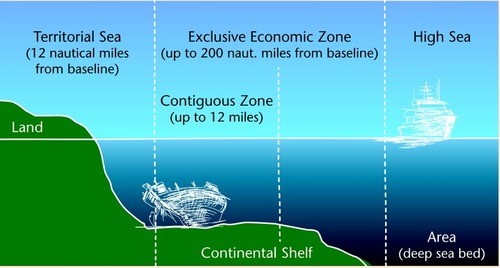29 Mar 2023 High Seas Treaty
High Seas Treaty
This article covers “Daily current events “and the topic is about ‘The High Seas Treaty’ which is in the news, it covers “International Institution” In GS-2, the following content has relevance for UPSC.
For Prelims: High Seas Treaty
For Mains: GS-2, International Institutions
Why in news: The nations of the world have agreed on a framework for the conservation and sustainable use of resources in the open oceans that lie beyond national territorial jurisdictions. This is why the agreement is a critical step forward in saving the planet — and also why it is important to temper expectations.
About High Seas Treaty
- The High Seas Treaty, formally known as the United Nations Convention on the Law of the Sea (UNCLOS), is an international treaty that was adopted in 1982 and came into force in 1994.
- The treaty defines the legal framework for activities on and in the world’s oceans and their resources, including fisheries, shipping, and the exploitation of mineral resources.
- UNCLOS sets out the rights and responsibilities of nations with respect to their use of the world’s oceans, establishing guidelines for maritime zones, including territorial waters, exclusive economic zones, and the high seas.
- It also provides rules for the protection and preservation of the marine environment, including regulations on marine pollution and the conservation of marine species.
- The treaty has been ratified by over 160 countries, making it one of the most widely accepted international agreements in history. However, some notable countries, including the United States, have not ratified the treaty.
Overall, the High Seas Treaty plays an important role in managing and regulating human activities in the world’s oceans, promoting international, cooperation and the protection of the marine environment.

High Seas Treaty
Key provisions of the High Seas Treaty include
- Territorial Waters: UNCLOS defines the territorial waters of a coastal state as extending up to 12 nautical miles from its baselines. Within this zone, the coastal state has sovereign rights over its natural resources and jurisdiction over activities, including shipping, fishing, and scientific research.
- Exclusive Economic Zones (EEZs): UNCLOS establishes a zone beyond the territorial waters of a coastal state extending up to 200 nautical miles from the baselines, in which the coastal state has exclusive rights over the exploration and exploitation of natural resources, including fish stocks and minerals.
- Freedom of Navigation: UNCLOS recognizes the freedom of navigation for all ships on the high seas, including military vessels. It also prohibits any interference with this freedom, except in limited circumstances, such as in cases of piracy, drug trafficking, or unauthorized broadcasting.
- Conservation of Marine Resources: UNCLOS requires that coastal states and other states cooperate in the conservation and management of living marine resources on the high seas. The treaty provides for the establishment of regional fisheries management organizations (RFMOs) to regulate fishing activities on the high seas and to ensure the conservation and sustainable use of fish stocks.
- Protection of the Marine Environment: UNCLOS requires that states take measures to protect the marine environment from pollution and other harmful activities. The treaty establishes rules for the prevention, reduction, and control of pollution from ships, including oil spills and other harmful substances.
- Settlement of Disputes: UNCLOS provides for the settlement of disputes arising from the interpretation or application of the treaty. Disputes can be resolved through negotiation, mediation, or other peaceful means, and the treaty also establishes mechanisms for the settlement of disputes through binding adjudication by an international tribunal.
These provisions, along with others outlined in the treaty, provide a comprehensive legal framework for the management and conservation of the world’s oceans and their resources.

High Sea Treaty
Challenges faced by High Seas Treaty
The High Seas Treaty is a complex international agreement that sets out rules and guidelines for the use of the world’s oceans and their resources. While the treaty has been ratified by most countries, it still faces several challenges, including:
- Enforcement: One of the biggest challenges of the High Seas Treaty is enforcing its provisions. The treaty covers a vast area of the ocean that is difficult to monitor and control, making it challenging to detect and stop illegal activities such as overfishing, piracy, and pollution.
- Jurisdiction: The treaty divides the ocean into different zones, each with its own set of rules and regulations. However, determining which laws apply to specific areas can be challenging, especially in cases where multiple countries claim jurisdiction over the same waters.
- Resource management: The treaty aims to promote sustainable use of the ocean’s resources, but managing these resources can be challenging. Issues such as overfishing, marine pollution, and climate change can have a significant impact on the health of the ocean and its ecosystems.
- Political will: The success of the High Seas Treaty depends on the willingness of governments to work together and uphold the provisions of the agreement. However, political and economic interests can sometimes conflict with environmental concerns, making it difficult to reach consensus on key issues.
- Technology: Advancements in technology have made it easier to explore and exploit the resources of the high seas, but these same technologies can also pose a threat to the environment. As technology continues to evolve, new challenges may emerge that the treaty is not equipped to handle.
Overall, the High Seas Treaty represents a significant step forward in the management and protection of the world’s oceans. However, ongoing efforts are needed to address the challenges it faces and ensure that it remains relevant and effective in the years to come.
India and High Seas Treaty
- As a party to the treaty, India is bound by its provisions and regulations for the use of the ocean and its resources. India has been actively involved in various aspects of the treaty, including the establishment of the International Seabed Authority (ISA), which is responsible for the management of the resources of the international seabed. India is a member of the ISA and has participated in the development of regulations for seabed mining.
- India has also played a significant role in the negotiations on the conservation and sustainable use of marine biodiversity beyond national jurisdiction, also known as the BBNJ negotiations. These negotiations aim to establish a new international legally binding instrument under UNCLOS for the conservation and sustainable use of marine biodiversity in areas beyond national jurisdiction.
- In addition to its participation in UNCLOS, India has taken several initiatives to protect and conserve its marine resources, including the implementation of the National Biodiversity Act, the Coastal Regulation Zone Notification, and the Marine Pollution Prevention Act. India has also established a national institute for oceanography and several marine research centers to promote scientific research and exploration of the ocean.
- However, like many other countries, India also faces several challenges in implementing the provisions of the treaty, including issues related to enforcement, resource management, and political will.
Way forward:
- Addressing these challenges will require continued collaboration and cooperation among countries and stakeholders to ensure the sustainable use and protection of the ocean and its resources.
Source:
Get daily current affairs from Yojna IAS


No Comments